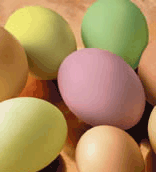
Easter Eggs Colors to Dye for
They're so beautiful, you'll want to dye eggs for Christmas!
By Marion Owen, Fearless Weeder for PlanTea, Inc. and
Co-author of Chicken Soup for the Gardener's Soul
FEATURE ARTICLE:

Tom Hanks' "Power of Four" solution
More good stuff:
Who is Marion Owen?
FAQs about PlanTea
Search Marion's articles, tips and recipes
Why grow organic?
News and press releases
Read love letters
How to link to this site
Need a speaker?
How to contact Marion
Visiting Alaska?
Come to Kodiak Island!
Go to home page

Marion's UpBeet Gardener
Newsletter has been
replaced by Marion's blog
which you can find at:
Marion Owen Lagniappe
 It's fun and easy to use fruits, vegetables and other foods to make your own natural Easter egg dyes. Natural egg dyes produce pleasing earth tones like the eggs at right (photo courtesy of Frontier Natural Products Co-op). What's more, you can use fresh, frozen or canned produce.
It's fun and easy to use fruits, vegetables and other foods to make your own natural Easter egg dyes. Natural egg dyes produce pleasing earth tones like the eggs at right (photo courtesy of Frontier Natural Products Co-op). What's more, you can use fresh, frozen or canned produce.
And you don't have to stop there. Creativity continues with tie-dyed eggs and wild patterns using rubber cement glue!
Here are some basic guidelines for transforming eggs into beautiful works of art:
+ Canned produce will produce much paler colors.
+ Boiling the colors with vinegar will result in deeper colors.
+ Some materials need to be boiled to impart their color (name followed by 'boiled' in the list below).
+ After your eggs dry, use a vegetable oil and soft cloth to polish them.
There are two basic ways to dye eggs: Cold dip and hot dip. The cold-dip method generally produces softer, more translucent tones.
Cold Dip Method #1:
Boil the eggs and ingredients separately. Let the dye cool, strain it and dip the eggs for 5 to 20 minutes (longer for deeper hues), then dry them on paper towels. To avoid uneven coloring, rotate the eggs occasionally.
Cold Dip Method #2:
I'm not trying to get complicated here by including another "cold" method, but some materials produce a nicer color by not being boiled. In this case, cover the boiled eggs with water, add dyeing materials, about a teaspoon of vinegar, and let the eggs remain in the refrigerator until the desired color is achieved.
Hot Dipping (preferred method):
 This method involves boiling the eggs in the dye, which gives darker colors. As the eggs roll around in the hot, dye water, they take on a uniform color. Place eggs in a single layer in a saucepan. Using a ratio of one tablespoon white vinegar for each quart of water, add liquid until the level is an inch or two above the eggs. Add dye ingredients and bring to a rolling boil. Reduce heat and simmer for 20 to 30 minutes. Rinse with lukewarm water.
This method involves boiling the eggs in the dye, which gives darker colors. As the eggs roll around in the hot, dye water, they take on a uniform color. Place eggs in a single layer in a saucepan. Using a ratio of one tablespoon white vinegar for each quart of water, add liquid until the level is an inch or two above the eggs. Add dye ingredients and bring to a rolling boil. Reduce heat and simmer for 20 to 30 minutes. Rinse with lukewarm water.
If you don't have the patience to experiment with natural dyes, but want to make Easter egg dye from scratch, try using good old food coloring. Drip (liquid, paste or gel) food coloring into bowls of water, and stir until the water reaches your desired hue. Try combining different colors to make original colors.
Place the hard-cooked eggs into the colored water and let them sit until the eggs reach the hue you like. Remove the eggs from the dye and let them air-dry. For another trick, make a dye water using unsweetened Kool-aid. Now I'm wondering if sugar-free Jell-O would work.
Colors to Dye for
Working with natural dyes generally takes longer than commercial, day-glow dyes, depending on how intense you want the colors. For darker tones, let the eggs sit in the dyes overnight in the refrigerator.
Here is a list of dye materials I've collected over the years from a variety of sources. Don't be afraid to experiment on your own.
RED
Pomegranate juice and lots of red onion skins (ask the produce man to save some for you). Boil with the eggs for 1/2 to 1 hour. Hibiscus flowers (you can find it in a dried tea form). Red wines (you don't have to add vinegar) also work great.
PINKBeets (shred or grate first), cranberries or cranberry juice, raspberries, grape juice, juice from pickled beets, crushed red currants.
VIOLET-BLUESoak hardboiled eggs overnight in hot water to which you have added crushed violet, pansy or geranium blossoms.
LAVENDER AND BLUEUse purple pansies, violets, or grape juice. For a darker lavender use frozen, fresh or canned (with the juice) blueberries, blackberries.
YELLOW AND GOLDOrange or lemon peels (boiled), carrot tops (boiled), celery seed (boiled), ground cumin (boiled), ground turmeric (boiled). To use turmeric, add 1 to two teaspoons of the spice and 1 teaspoon white vinegar to a cup of hot water. Also try ground yellow mustard, saffron, curry powder; goldenrod, tansy, dandelion and daffodil blossoms.
GREEN
Add 1/4 teaspoon baking soda to a bowl of "violet blue" colored water before soaking the eggs. You can also soak eggs in boiled spinach water or liquid chlorophyll (available at natural food stores) or I dare you to try mixing a handful of fresh grass clippings and a little vinegar and water in a blender.
BROWN
To a cup of hot water, add 3 tablespoons instant coffee and 1/2 teaspoon vinegar. Boiled back walnuts shells also produce a nice brown color.
How to Produce Color Variations
Rub or squish blueberries and cranberries directly on the dry shells for soft blues and pink. Mix them up for blotchy colors. Also, I've heard that a brown egg boiled in red cabbage dye and then soaked overnight, will come out a deep royal blue.
Designs and Patterns
Once the eggs have been hard-cooked and dried, hold one egg in your hand and drip glue (such as rubber cement) onto the egg's surface. Drip the glue carefully to make a particular pattern, or just let the glue drip freely for an abstract effect. Place the egg on a stand that will allow the glue to dry without getting smudged. When the glue has dried, place the eggs in a prepared dye mixture until they are tinted to your liking. Remove them from the liquid and peel off the glue.
Tie-Dyed Eggs
Collect a handful of different sized rubber bands. Wrap the bands, one at a time, around the eggs. Dye the eggs, remove them from the liquid and let them dry completely before pulling off the rubber bands.
Crayon Eggs
Perhaps the easiest technique of all is the color-with-crayons method. Simply draw a design onto your eggs and then dye as you would any other Easter egg.
Half 'n Half Eggs
Dip dyed eggs into a second coat of darker dye to add a whole new color. The first coat is boiled and the second is cold-dipped for 5 to 10 minutes. To cold-dip, place egg in a small glass bowl or paper cup and prop it up against the side. Some great color combinations include coffee and blueberry; turmeric and red cabbage; and onion skins and cranberry juice.
It's a Wrap: With Onion Skins
This method is a little messy, but the results are always a pleasant surprise. Rub eggs with white vinegar and wrap in onion skins. Secure the skins with cotton string, dental floss, narrow rubber bands or nylon stocking. When boiled, the skins dye the shells giving a natural tie-dye look. To achieve a full, rich effect, practice using many layers of onion skins. Hint: Pre-dampening the skins helps them stick to the egg.
After dyeing eggs with your own colorful concoctions, you'll find yourself looking at your garden and products in the store with an artist's eye. Remember, don't limit your egg dyeing adventures to the Easter holiday. Colorful, hard-boiled eggs are fun any time of the year. Red and green for Christmas eggs?
![]()
Thanks for visiting and please stop by again. I'll put the coffee on!
Meet Marion Owen /// Learn about PlanTea /// Online Catalog /// Articles, Tips, Recipes /// Get free UpBeet Gardener newsletter /// Read current issue /// Listen to radio show /// Read news and press releases /// More resources and links /// Learn why 'grow organic?' /// View guidelines for retailers /// Read love letters /// Book Marion as a speaker /// Site map /// How to link to us /// Contact us /// Go to home page
PlanTea: The organic plant food in tea bags. http://www.plantea.com
Copyright �1996 to present: PlanTea, Inc. All Rights Reserved. PO Box 1980, Kodiak, AK 99615-1980 USA
Questions or comments? marion@plantea.com Phone: Toll Free: 1-800-253-6331 (US and Canada); 907-486-2500